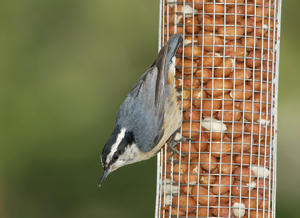Fun Facts About Red-Breasted Nuthatches

- The name Nuthatch probably results from the corruption of the word “nuthack” which refers to its’ habit of hacking away at a seed with its beak until it opens.
- Red-breasted Nuthatches favor living in spruce and fir trees.
- A nuthatch’s foot has one big toe (the hallux) that faces backward, while its other three toes face forward. They are able to walk head first down the trunks of trees by moving only one foot at a time while the hallux toe on the other foot holds firmly to the bark.
- Nuthatches are monogamous and defend a territory throughout the year.
- The Red-breasted Nuthatch will line the entrance to its nesting cavity with drops of sticky conifer resin. It is thought that this may be a tactic to discourage predators or nest competitors from entering the cavity. The nuthatches avoid the resin themselves by diving directly into the nesting cavity without ever touching the sides of the entry hole.
- The Red-breasted Nuthatch is a very aggressive defender of its nesting cavity, especially during the building period. It chases away much larger birds such as the Downy Woodpecker and it has even been observed to bully the very aggressive House Wren.
- When natural food supplies are scarce in northern Canada, numerous species of birds will “irrupt” into a southern migration in search of food. Red-breasted Nuthatches are typically the earliest species to head south for the winter, leaving as early as mid-summer and settling into their new southern winter territories by the end of September.
- The longevity records for Nuthatches are: White-breasted – 9 years, 10 months; Red-breasted – 7.5 years; Brown-headed – 5 years, 9 months; Pygmy – 8 years, 2 months.
Check out this video about Nuthatches!

